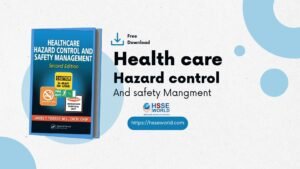E-Books: Evaluation of Fire Safety free download
7 min read
Evaluation of Fire Safety is a comprehensive book that explores different aspects of fire safety, ranging from the nature of the fire hazard, major fire hazard areas, and the cost of fires to the prescriptive and functional approach to fire safety. The book discusses the fire safety system, including its objectives, design steps, and sources of fire safety data. It examines various subsystems such as fire occurrence and prevention, fire development and control, harmful effects, and fire safety design and management. The book also covers the contribution of fire safety engineering, approaches to quantitative evaluation of fire safety, and risk management.
The nature of the fire hazard
The hazard of fire is the consequence of uncontrolled, exothermic chemical reactions, especially between organic materials and air. It is particularly associated with combustible materials and energy sources used by people in everyday life. Although fire threatens both life and property and its control occasions much expenditure, the hazard must be set against the benefit gained from these resources so that a balanced view can be obtained. Moreover, living standards are highly dependent on the use of buildings. The extra danger when fires occur in an enclosure, with the heat and smoke being trapped rather than moving relatively harmlessly upward, needs to be set against the intrinsic value of using buildings. It follows that one cannot, in general, eliminate fire hazards, although one can reduce it to an acceptably low level by suitable design procedures.
Also Read: Chemical Risk Assessment form

Interaction between fire hazard and other hazards
Fire takes its place alongside many other hazards in living. These include health hazards such as epidemics and sickness, industrial transportation, and domestic accidents, as well as natural
hazards such as earthquakes, floods, hurricanes, and so on. The fire hazard can of course be reduced by a severe restriction on the use of energy and combustible materials, but this could bring in its wake suffering and cost in excess of any alleviation of the fire problem. It could even give rise to conditions that prompt other hazards, particularly health hazards. There is a tendency for people who specialize in fire safety to look at the fire problem in isolation. One must be careful not to lose perspective in so doing, for example, with regard to the benefits that might ensue from using a material or process that might incidentally impose an increased fire hazard.
This point is illustrated diagrammatically in Figure 1.1 (Rasbash, 1974). Risks are associated with the act of living. Some risks have to be taken, while others are taken voluntarily. Risks are taken to obtain a benefit, of which perhaps a notional measure might be denoted by A. Amongst the risks, there are those with fire, which may inflict a penalty of “detriment” of fire damage and hurt because of fire occurrence. These may be assigned a notional value of fd (“d” for detriment). The fire danger requires a fire safety program that inflicts a cost of fc (“c” for cost). In the same way, other hazard scenarios inflict detriment hd, and the safety program costs of hc. The object of any rational program toward controlling fire safety should be to maximize the total benefit: [A – (fd + fc) -(hd + hc)].
Also Read: Photo of the day: Fire Emergency

Two examples serve to illustrate this point. Insulation in houses saves energy and would thus increase A. Insulation, particularly on the inside surfaces of a room, is also known to increase the rate of fire spread even if the insulation is not combustible. The introduction of such insulation would therefore serve to increase fd. Would [A – fd] be increased by the introduction of insulation? Many effective insulating materials are in themselves highly flammable. This tends to rule out their use on interior walls. It is normal in these circumstances to introduce a noncombustible layer on the inside wall with extra cost fc. In this case, the relevant benefit is the change in the value of [A – (fd + fc)].
The provision of smoke-stop doors is common in buildings, particularly in the United Kingdom. These of course occasion a certain cost that contributes to fc. As long as they can be opened when necessary by people escaping a fire, such doors reduce the risk of death in the event of a fire and thus reduce fd. But an extra cost that tends not to be brought into the equation is the inconvenience of having these doors scattered about buildings, particularly for those who have a physical handicap. There is a consequent reduction of the general benefit factor A, although in this case, the reduction is difficult to quantify. This factor usually manifests itself by the doors being propped open much of the time, thus nullifying much of the reduction in fd. Again, this can be overcome by having such doors held open and closed only following the automatic detection of fire. This substantially increases the cost of fc.
Major fire hazard areas
Fires causing loss and damage can occur wherever human activity occurs. Perhaps the most frequent location for fires is within buildings. These include both domestic and non-domestic premises, and the latter can extend to a wide range of occupancy, such as factories of various kinds, buildings where there are special risks to the public, including places of public assembly, and places where people sleep, such as hotels and hospitals. Industrial occupancies extend beyond buildings to include mines, process plants housed in the open, offshore installations, agricultural crops, and forestry. Finally, there is a whole range of facilities for road, rail, marine, and air transport even extending in recent times to satellites and space modules. For most of these hazard areas, a considerable and costly fire occurrence background has built up over the years and has given rise to extensive requirements for fire safety. In the world of fire insurance, specific hazard areas are often called “risks.”
Also Read: Common Scenarios to Be Prepared For Emergency Response Situations
Contents
The content of the Evaluation of Fire Safety
- The Place of fire safety in the Community
- The fire safety system
- Review of some major fire & explosion disasters
- Requirements from public and private authorities for fire safety
- QUANTIFYING FIRE SAFETY
- Portable Fire Extinguishers
- Sources of statistical data
- Occurrence and growth of the fire
- Life loss
- Property damage
- Fire Protection Engineering in Building Design
- Performance of fire safety measures
- Deterministic fire safety modeling
- Model Validation
- Point systems – a single index
- Logic trees
- A Guide to Fire Safety Engineering
- Stochastic fire risk modeling
- Fire safety concepts tree and derivative approaches
- Fire Safety Assessment in the process industries
Also Read: Workplace Fire Safety Program
You can Download Other safety Resources at https://safetybagresources.com/
Download the book
E-Books: Evaluation of Fire Safety
More Downloads
- E-Books: Healthcare Hazard Control & Safety Management
- E-Books: Safety, Health and Working Conditions Training Manual
- E-Books: Energy Efficiency in Water and Wastewater Facilities
- E-Books: Fire Service Features of Buildings and Fire Protection Systems
- E-Books: Evaluation of Fire Safety free download
- E-Books: PPE for Chemical, Biological, and Radiological Hazards free
- E-Books: Changing the Workplace Safety Culture free download
- E-Books: Site Emergency Planning Workbook
- E-Books: Load Restraint Guide
- E-Books: Essential Practices for Creating, Strengthening, and Sustaining Process Safety Culture
- E-Books: System Safety Engineering and Risk Assessment
- E-Books: Permit-Required Confined Spaces
- E-Books: Is it Safe to Enter Confined Space?
- E-Books: 5-Minute Workplace Safety Talks
- E-Books: Safety Culture and High-Risk Environments
- E-Books: Practical Guide to Industrial Safety
- E-Books: Slip, Trip, and Fall Prevention for Healthcare Workers
- E-Books: Health and Safety at Work Key Terms
- E-Books: Fundamentals of Process Safety Engineering
- E-Books: Gas Detection Hand Book
- E-Books: Occupational health and safety management systems ANSI-AIHA-z10-2012
- E-Books: Hot Work on Drums and Tanks
- E-Books: Human Fatigue Risk Management
- E-Books: Guidelines for the provision of facilities and general safety in the construction industry
- E-Books: Handbook of Training in Mine Rescue and Recovery Operations ( 2021)
- E-Books: Code of Practice for the Safe Use of Lifting Equipment – Edition 9 (Nov 2019)
- E-Books: Free Forklift Health and Safety Best Practices Guideline
- E-Books: Handbook of Hazardous Chemical Properties
- E-Books: Human Performance Improvement through Human Error Prevention
- E-Books: Principles Of Fire Risk Assessment In Buildings
- E-Books: Investigation of Occupational Accidents and Diseases
- E-Books: Radiation Protection and Safety in Industrial Radiography
- E-Books: Basic Guide to System Safety, Third Edition
- E-Books: Food Safety Management-A Practical Guide for the Food Industry
- E-Books: Safety identification: Escape and evacuation plan signs- ISO 23601
- E-Books: Safety at Work
- E-Books: The Safety-Critical Systems Handbook 4th edition
- E-Books: Fundamental principles of occupational health and safety
- E-Books: Fire Safety Risk assessment Guide – Sleeping Accommodation
- E-Books: Mental health at work series
- E-Books: Live Fire Training: Principles and Practice
- E-Books: Pre-Startup Safety Review Guide
- E-Books: Fire and Emergency Drill Manual and Building Inspection Guide
- E-Books: Health and Safety: Risk Management 5th edition
- E-Books: Fire Protection systems -Third edition 2021
- E-Books: Fire Safety Logbook templates
- E-Books: From Accidents to Zero
- E-Books: Electric Safety Practice and Standards
- Your steps to chemical safety
- E-Books: Ergonomics and Psychology Developments in Theory and Practice
- E-Books: HAZOPS Should BE fun-The Stream-Based HAZOP
- E-Books: Safety Health and Environmental Auditing
- E-Books: A Quick Guide to Health and Safety
- E-Books: Occupational Ergonomics A Practical Approach
- E-Books: Job Hazard Analysis A Guide for Voluntary Compliance and Beyond
- E-Books: Electrical Safety of Low Voltage Systems



